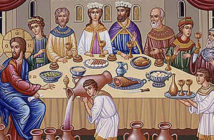 Source: Public Orthodoxy
Source: Public Orthodoxy
by Mark Arey
Originally posted on June 1, 2017.
The recent visit of the President and First Lady to the Vatican raised again the question of head coverings for women in the Christian context. Many Christians perpetuate a theology of women’s submission to men that is symbolized by head coverings, based on a Scriptural text (First Corinthians 11:3-16).
In 11:5, Paul stresses the Jewish custom that married women should cover their head. Every wife who prays or prophesies with her head uncovered, dishonors her own head. Indeed, it is the same thing as having a shaved head!
As pointed out by M.D. Hooker, “According to Jewish custom, a bride went bareheaded until her marriage, as a symbol of her freedom; when married, she wore a veil as a sign that she was under the authority of her husband” (Authority on Her Head: An Examination of I Cor. XI. 10, New Testament Studies, 10, 1964, pg. 413). As Paul progresses in his argument in verses 8 and 9, he relies on the Genesis account of the creation of man and woman (Genesis 2:18-25) to create his logic. Thus, by the time we get to verse 10, we have a curious conclusion to his reasoning: That is why it is appropriate for a wife to have authority over her head, on account of the Angels.
Most translations take the word exousia, whose basic meaning is “authority,” to mean a symbol of authority, i.e. a veil. A few manuscript traditions actually replace the word exousia with the word “veil” (Greek, kalumma). This probably means that the poor scribe who was copying the text was so confused that he made the well intentioned substitution in order to clear things up!
By adding the phrase “symbol of” to the word “authority” (Greek, exousia) in verse 10, “authority” becomes a physical object. Even A Greek-English Lexicon of the New Testament and Other Early Christian Literature theorizes that such veils were necessary to guard the women from “the amorous glances of certain angels.” This seems ridiculous at best and disturbing at worst. What is more egregious, generations of biblical literalists then use this extra word – nowhere in the original text – to justify a practice of veiling women.
This and other such speculations resort to invention that are simply not borne out by the original Greek. Exousia means “authority,” not an article of clothing. In this same Epistle (7:3,4), Paul discusses sexual expression within marriage in terms of “authority,” with the same word in its verbal form, exousiazo:
7:3) A husband must yield to his wife the loving affection that is proper and due, and likewise a wife to her husband. 7:4) A wife does not have authority over her own body, but her husband. And in the same way, a husband does not have authority over his own body; rather it is his wife who rules.
A woman having authority over her head (11:10), her head being her husband, is an affirmation of the unity and equality of spouses in the marriage state. Within the state of matrimony, such equilibrium is necessary if the couple is to achieve the salvific meaning of their union in Christ.
As for the angels, this reference may not be as oblique as has been thought. Paul mines Psalm 8 for much theological material (as in 15:27-28 of this Epistle and in Hebrews 2:6-10). In this Psalm, the verses 5,6b: What is man that you remember him, or the son of man that you visit him? You have lowered him a little more than the angels; you have crowned him with glory and honor. You have set him over the works of your hands, are interpreted as a reference to Christ. In the Orthodox Church, the expression, crowned with glory and honor, has come to be associated with the actual moment of marriage, when the wedding crowns are placed on the bride and groom. Through marriage, men and women participate in the saving ministry of Christ. Hence, there is a necessity for a woman to be in balance, in right relationship with her husband, and for the husband not to lord over his wife. This view of marriage negates the antagonistic relationship described as a consequence of the Adamic Sin (the “Fall”) as described regarding woman in Genesis 3:16: your means shall be with (you shall be dependent upon) your husband and he shall lord (kurieusei) over you. The inequality and indeed division which was a result of the “Fall” is overcome in Christ, a view maintained by St. Maximus the Confessor.
So why the angels? The restoration of the balance of men and women in marriage is part and parcel of the exalted position of humankind, which is now placed above the angels through Christ. “On account of the angels” is not so much a reason for the wife to have “authority over (spatially) her head,” (a physical head and thus the theory of a “symbol” or “veil”), but a consequence of the new reality of humankind in Christ. Her exercise of “authority over (relationally) her head” (her husband) – in particular through the exercise of their mutual sexuality – is a manifestation of the “crown of glory and honor” that humanity experiences in Christ, and the superiority of humanity over the angels in and by Christ. In Christ, God became a human being, not an angel. The Corinthians must not forget their exalted position. As Paul reminds them elsewhere in this Epistle (6:3), they will even judge angels.
Finally, Paul does not insist on veils (11:15), as long as women appear like women, i.e., wear their hair long; But, if a woman grows her hair long, it is a glory to her, because her mane of hair is given to her in place of a covering. Many translations render ἀντί (anti), in verse 15 as “for” or “as,” in order to make the meaning of verse 15 to be a confirmation that wives must veil their heads. Such a translation is based on a false understanding of exousia in verse 10. A correct translation of anti would be “in place of,” “instead of,” or “as an equivalent to” (as in “Anti-Christ”).
Paul does not ultimately insist that women wear veils, nor does he preach the submission of women to men. In fact, there is no such insistence on any such particularly Jewish custom for this Gentile community in Corinth, or anywhere else. The confrontation of the new Jewish faith in Christ with pagan culture was difficult for sure, and morality was a chief concern. But we must look at these issues through their eyes, and not perpetuate notions of static custom and practice that were in fact dynamic and evolving.
Mark Arey was a priest of the GOA for over 30 years. His most recent book is “The Gospel of Love: A Meta-Translation” (more at www.markarey.com). Arey served on one of OCL’s commissions on the Project for Orthodox Renewal …co-authoring a study on Mission and Outreach (pp. 47-71) with Fr. Steven Vlachos.



5 Comments
Another example of being able to prove any nonsensical idea with proof texting…
This essay offers some unique ideas for contemplation.
In the interest of presenting a diverse & balanced perspective here is a link to Fr. John Whiteford’s refutation of Mark Arey’s essay: http://www.pravoslavie.ru/english/104571.htm
When I read at the end the names of books he worked on I came to a conclusion he is a liberal. And may be this site too. If the site isnt then they need to put both articles.
Bla, bla , bla, bla , bla , bla, bla …. All Power to the Vanguard of the Liberalatariat! NO headcoverings in Church necessary! Maybe non eshold be allowed … but, as that may rile some “Transgender” … persons … guess can’t go that far! Best laid plans … oh, well!
The glory of man is woman. The glory of a woman is her hair. “Can you not judge for yourselves what is right?” asks St. Paul……please Mr. Arrey…..don’t throw the baby out with the bathwater. We all know St. Paul had to admonish early Christian women for their ornate hairdos and jewelry in Church. Do you REALLY think that he didn’t care about headcoverings being used? The same old stuff goes on today. Too much of the flesh during Liturgy. People there to see their friends or because it is a Great Feast, or the immature teens still under the guidance of the adults. A woman doesn’t have to be a widowed Yia-Yia, wearing a complete suit of black, in order to be righteously wearing a headcovering. I was received into the Greek Church in American after the 1970’s when it was deemed IMPROPER by certain Bishops (by the way, they were only American Bishops) to wear a covering on my head, and I continued to fight for that right. Let’s do as St. Paul says. You’d be surprised. A Muslim family has converted to Christianity recently…in part by my being their first “close” Christian friends and their “respect of my modesty as a Christian”!!